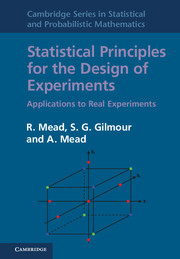20 - Sequential aspects of experiments and experimental programmes
from Part IV - Coda
Published online by Cambridge University Press: 05 November 2012
Summary
Experimentation is sequential
No experiment is an island, complete of itself, as John Donne might have said if he had been interested in formal scientific experimentation. There must, presumably, have been first experiments in all scientific fields, but in modern experimentation the design of each new experiment depends in varying degrees on the information gained from previous experiments and/or other, non-experimental, studies. This information comes in many different forms which are considered in the next section.
Sometimes experiments are designed quite deliberately in sequences to achieve a final result. This happens most obviously in selection programmes where it is known that the programme will start with a very large number of possible alternatives, which will be whittled down during a sequence of experiments to one, or a small number of, best choices. Screening programmes operate in a similar fashion.
In the development of new pharmaceutical drugs there is a very formal sequence of experiments which must be completed before the new drug can be accepted as available to medical science. This process moves from an essentially screening initial stage through to a very precisely controlled final clinical trial where the ideal drug dosage will be examined for a large number of randomly allocated subjects under controlled circumstances for a broad population.
Another area where experimentation is sequential is in the search for optimal conditions when several factors may be varied. The number of factors can become very large and the process may be partly a screening process to identify which factor levels have an effect followed by a search for the optimal conditions.
- Type
- Chapter
- Information
- Statistical Principles for the Design of ExperimentsApplications to Real Experiments, pp. 528 - 537Publisher: Cambridge University PressPrint publication year: 2012



